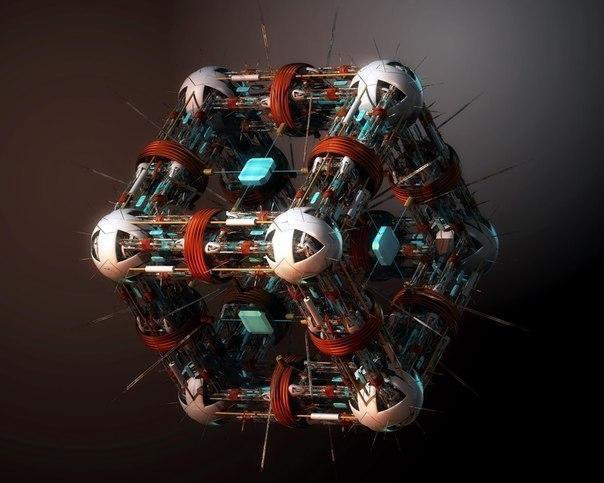10 technologies for the next 10 years
 Bashny.Net
Bashny.Net
We were lucky to be born and to live in an incredible time of development of science and technology. We know the approximate speed of development of both, but don't have the slightest idea what will be the speed to the end of our life. Things that have long been considered science fiction, day in and day components of our lives. In the next ten years the world can give us such gifts that it is impossible to refuse.

Amazing in all these scientific discoveries it that they create technology that will further accelerate technical progress. Our ability to innovate is increasing exponentially as the years go by. To give you an idea of the significance of this progression, here's 10 innovations that will change our lives by 2020.
1. Biotechnology
Yes, while these technologies will not give you the ability to break stones with his hands, but will allow people without fingers to have fully functional hands that can pick up items and to work with fragile objects. They are completely controlled by the power of thought and do not require surgical intervention. Touch Bionics, a company that develops hand Pro Digits, can install the hand complete with "living skin", a plastic covering resembling human skin, only 50 000 dollars. Small price to pay for a new hand.
2. Architecture
Although Dubai today is known for its excessive extravagance, in different regions engineers build buildings that are very interesting and practical applications.
This beautiful building will be constructed of 59 independent rotating modules/floors, so residents will be able to see a different picture outside the window. Each floor will rotate at a speed of approximately 6 meters per minute, so that the residents will not even notice its movement. Independent rotation will also give the building a constantly changing appearance, which will depict a very complex design.
All of this aesthetics very attractive, but the real innovations are hidden in wind turbines built in between each floor. Clean energy from their work will be enough to power the tower and several buildings nearby.
3. Computer speed, size and usability
Most of our website visitors know about Moore's law (number of transistors that can inexpensively be placed in a computer chip, doubles every year, which means doubling the speed). But most do not know that Moore himself came out and said that his law is likely to successfully finish its work by the year 2020, when the number of transistors that we can pack into a chip, will be limited by the laws of physics. Does this mean that exponential growth in computer processing speed will be halved in ten years?
In any case, says Jim Tully, head of semiconductors at Gartner research.
"The technology that will replace it will take a bottom-up approach when the chips are assembled from individual atoms or molecules, a kind of nanotechnology".
Ray Kurzweil, the esteemed futurologist, in 2008, declared that when by 2020 there will be a similar molecular computing, computers will have the intellectual abilities of people. Maybe you need to think for a moment, before moving on to the next item.
MacBook Air is a very thin laptop. So thin that makes you wonder: what will computers in 2020? According to developers at Intel, need the keyboard and mouse will not. Who needs them when you can control the computer by the power of the mind?
"We're trying to prove you can do interesting things with brain waves, says developer Dean Pomerleau Intel. — In the end people will get used to the brain implants. Imagine being able to view a web page the power of your thoughts".
Pomerleau and countless research groups around the world working scanning devices of the brain to display its bloodstream. They found that when different people focus on one image, their brains show similar patterns of blood flow. One British group even reported being able to distinguish between the types of virtual space, represented by people based on what type made the blood flow in their brain.
4. Machine and fuel
There are many different types of fuel for the so-called car of tomorrow, but the only species that has a realistic chance of use in the next ten years, is electricity. We still can't figure out how to make hydrogen fuel cells an efficient, safe and practical, and hybrid cars have become in the past.
It is a sedan Tesla Model S, which, according to the promise Elon musk, will be sold next year at a price of 35 000 dollars. In addition, after the recent announcement that Tesla is ready to share its technology with everyone, there remains no doubt that electric cars are evolving and will soon fill the market.
5. How we interact with the world
The way in which we interact with the outside world has seriously changed since the advent of the Internet, smartphones, and other benefits of civilization. In the very near future there will be another huge leap forward: integration of information on the Internet with our environment. The so-called Internet of things.
We can look at structure, product or place and get all the information about this subject. This will help us ordinary smartphone or Google glasses. What we had used, augmented reality will become a constant companion by 2020.
6. Energy
Solar energy will soon leave fossil fuels behind. The cost per watt of solar energy is falling rapidly, while the total amount of solar energy is growing exponentially. In fact, it doubles every two years over the past twenty years.
Help the development of these technologies, companies like Sandia. In 2010, Sandia has introduced solar panels, which require 100 times less material in design than modern solar panels, but works with the same efficiency. Furthermore, additional efficiency provide system analysts to support solar panels or wind turbines. These technologies made the list of the ten most important technologies 2014 version of the Massachusetts Institute of technology.
7. Health
Although we still can't cure the common cold with a simple click of the fingers, organs to order — the realities of tomorrow. Company Organovo several years ago developed the first commercial 3D bio-printer that builds the bodies cell by cell. Each individual cell is grown from the cells of the person who needs the organs. Now scientists have found a way to grow veins and arteries on this printer and first printed the heart and liver appear within ten years.
More generally, nanotechnology revolutionizing the world of health. An amazing combination of understanding of DNA and create very small cellular parts paints a very bright future for medicine. Edit the genome and the potential treatment of diseases such as schizophrenia, autism and PTSD, at the genetic level is not far off.
8. Equal opportunity
Of course, nobody says how a certain John DOE awakens and gains recognition and fame. The Internet has become an excellent platform for work, so now do not need millions to realize your idea — you can contact the people on the crowdfunding service to raise money even on the most insane idea.
10-year-olds are making thousands, making viral videos on YouTube. Anyone with a business idea can start a website and quickly gain the right amount. Even Twitter can be a way to attract attention, if you let the flow in the desired direction.
The Internet has become not just a convenient mechanism for doing business. He put on one stage the possibilities — and big business sharks, and dreamers.
9. Robots
The first decade of the 21st century was a great time for innovation in robotics. It just paved the way for General insanity on robots of different types. Although we are still far from creating robot maids, which will help us at home, companies like Google are making great strides to create different kind of useful and innovative robots.
Robots are already able to represent their emotions, react to your raise of the car and balance on one leg. What will happen tomorrow nobody knows, but the prospects of this sector very high.
10. Nanotechnology in clothes
Let's order.
Nanofibres will make the garment extremely comfortable and durable. In addition, the product will meet your personal preferences before you wear it.
Nanogenerators based on nanofibers will be able to produce electrical energy in clothing from your movements, ultrasonic waves and even blood flow. If we combine these fibers in double or triple layer clothing, it will be possible to create a flexible, foldable and wearable power source that will allow people to generate electricity when walking. published
P. S. And remember, only by changing their consumption — together we change the world! ©
Hydrophobic (water resistant) nanofibers will make fully waterproof clothing. She can lie in water for two months and remains dry to the touch. What else would you like?
Source: vk.com/wiki_inventions?z=photo-56414092_377355639%2Falbum-56414092_00%2Frev
Tags
See also
Mercedes-Benz introduced the concept of an unmanned car of the future
Top 10 most spectacular extraterrestrial Storm and Storm
This threatens to senile dementia
Number Subconscious: Cooperation in partnership
Our death programmed?
10 things to do till 30 years
15 rules for success in work and life!
North American International Auto Show (30 photos)
As the killer of 77 people sitting in "the most liberal countries in the world"
Salary - the amount for which you feel

















